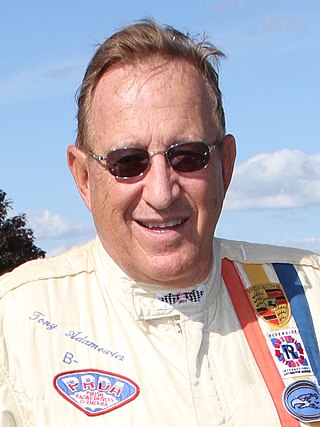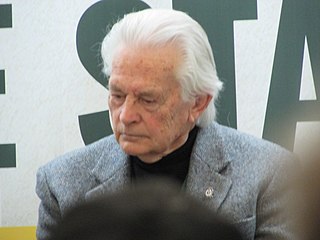Related Research Articles

Daniel Sexton Gurney was an American racing driver, race car constructor, and team owner who reached racing's highest levels starting in 1958. Gurney won races in the Formula One, Indy Car, NASCAR, Can-Am, and Trans-Am Series. Gurney is the first of three drivers to have won races in sports cars (1958), Formula One (1962), NASCAR (1963), and Indy cars (1967), the other two being Mario Andretti and Juan Pablo Montoya.

John Cannon was a sports car racer, who competed under the banner of Canada, though he was born in London, U.K. He raced in the USRRC series, the CanAm Series and the L&M Continental Series.
Theodore Racing was a Formula One constructor from Hong Kong founded by real estate magnate and millionaire Teddy Yip. They participated in 51 grands prix, entering a total of 64 cars.

All American Racers is an American-licensed auto racing team and constructor based in Santa Ana, California. Founded by Dan Gurney and Carroll Shelby in 1964, All American Racers initially participated in American sports car and Champ Car races as well as international Formula One events with cars named Eagle. The Formula One team, based in the United Kingdom and using British-built Weslake engines was named Anglo American Racers. Under team manager Bill Dunne they set up shop in Rye, East Sussex. The team were adjacent to Harry Weslake's engine development plant and half a mile from Elva cars. They participated in 25 Grands Prix, entering a total of 34 cars.

The Canadian-American Challenge Cup, or Can-Am, was an SCCA/CASC sports car racing series from 1966 to 1987.

Formula 5000 was an open wheel, single seater auto-racing formula that ran in different series in various regions around the world from 1968 to 1982. It was originally intended as a low-cost series aimed at open-wheel racing cars that no longer fit into any particular formula. The '5000' denomination comes from the maximum 5.0 litre engine capacity allowed in the cars, although many cars ran with smaller engines. Manufacturers included McLaren, Eagle, March, Lola, Lotus, Elfin, Matich and Chevron.
Chaparral Cars was a pioneering American automobile racing team and race car developer that engineered, built, and raced cars from 1963 through 1970. Founded in 1962 by American Formula One racers Hap Sharp and Jim Hall, it was named after the roadrunner, a fast-running ground cuckoo also known as a chaparral bird.

The Eagle Mk1, commonly referred to as the Eagle T1G, was a Formula One racing car, designed by Len Terry for Dan Gurney's Anglo American Racers team. The Eagle, introduced for the start of the 1966 Formula One season, is often regarded as being one of the most beautiful Grand Prix cars ever raced at the top levels of international motorsport. Initially appearing with a 2.7L Coventry Climax inline 4-cylinder engine, the car was designed around a 3.0L Gurney-Weslake V12 which was introduced after its first four races. In the hands of team boss Gurney, the Eagle-Weslake won the 1967 Belgian Grand Prix, making Dan Gurney only the second driver at the time, and one of only three to date, to win a Formula One Grand Prix in a car of their own construction. Excluding the Indianapolis 500, that win in Belgium still stands as the only win for a USA-built car as well as one of only two wins of an American-licensed constructor in Formula One. It was also the first win for an American constructor in a Grand Prix race since the Jimmy Murphy's triumph with Duesenberg at the 1921 French Grand Prix.

Anthony Peter Adamowicz was an American racing driver, active from 1963 until his death. He won the Under 2-Liter class of the 1968 Trans-Am Championship and the 1969 SCCA Continental Championship.
Leonard Bailey was a British automobile designer.

The Eagle HF89 and its evolution, the Eagle HF90, is a racing car built and entered by Dan Gurney's All American Racers team, for the IMSA GT Championship. It was raced from 1989 until 1991 in IMSA's premier sports-car racing category, the GTP division. The design was also sometimes called the Eagle MkII.

Tony Southgate is a British engineer and former racing car designer. He designed many successful cars, including Jaguar's Le Mans-winning XJR-9, and cars for almost every type of circuit racing. He was responsible for the chassis design of Ford's RS200 Group B rally car. Southgate was employed as chief designer or technical director for many Formula One teams for over twenty years. These teams included BRM, Shadow and Arrows. Southgate retired after producing the Audi R8C, which was a major influence in the Bentley Speed 8, which won Le Mans in 2003. He continues to be a regular visitor to current and historic race meetings.

The Lotus 69 was an open-wheel formula racing car developed by Lotus in 1969 for use in Formula 2, Formula 3, and Formula Ford.
The 1968 SCCA Grand Prix Championship was the second annual running of the Sports Car Club of America's open wheel automobile racing series later to become known as the SCCA Continental Championship. The championship was open to SCCA Formula A, Formula B and Formula C cars, with Formula A expanded to include vehicles powered by 5 liter production-based engines, with the Formula A category later being renamed to Formula 5000.
Leonard E. Terry was an English racing car designer and engineer, known for his work with Lotus, BRM and Eagle. He also designed chassis for many other teams, including ERA and Aston Martin and produced his own car in which he competed.
Keith Holland is a British former racing driver from England who competed in various classes of racing in the 1960s and 1970s. He is known for winning the 1969 Madrid Grand Prix in a Formula 5000 car in a field which contained several Formula One entries. He was also a regular competitor in the British Formula 5000 Championship finishing third in the title standings on two occasions.
Autodynamics Inc. is a former American racecar manufacturer based in Marblehead, Massachusetts. The company mainly produced Formula Vee and Formula Ford chassis. The company was also active in the Trans-Am Series entering Dodge Challengers in the 1970 season.

The Eagle 755 was a race car designed and built by Eagle for use in Formula 5000 racing and made its racing debut in 1975, and competed until 1976, when the SCCA Continental Championship dissolved. The Eagle 755 was powered by the commonly used 5.0-liter Chevrolet V8 engine.

The Chevron B24 was a Formula 5000 racing car developed by Chevron Cars in 1972.
The Surtees TS5 was a Formula 5000 racing car, designed, developed, and built by Surtees between 1969 and 1970.
References
- ↑ "1969 AAR Eagle Mk 5 F5000 #7 | Monterey 2016". RM Sotheby's.
- ↑ Brown, Allen (2 September 2021). "Eagle 1968/69 Formula A 'Mk 5' car-by-car histories". OldRacingCars.com.
- ↑ "1969 AAR Eagle Mk 5 F5000". Sports Car Market. 10 October 2016.
- ↑ "1969 AAR Eagle Mark 5". conceptcarz.com.
- ↑ "Eagle « F5000 « OldRacingCars.com". www.oldracingcars.com.
- ↑ "Eagle". www.f5000registry.com.